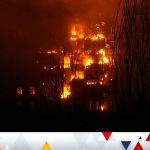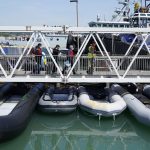The torrent of water unleashed by the breaching of the Nova Kakhovka dam has engulfed whole villages, towns, agricultural land and large sections of Kherson city in southern Ukraine.
We watched as the waters rose and rose in Kherson city – sweeping debris, branches, tyres and anything else in its path.
Residents scrambled to leave their flooded homes in safety, sometimes just clutching pets and important documents and very little else.
87-year-old Tamara struggled out of a taxi that drew up along one of the main streets in the city to search for her cats.
“My babies, my babies,” she wailed. “I have to find my babies.”
A cat was handed out of the window of her flat to a relative who was helping her rescue her pets. But, the cat, clearly terrified, wriggled, bit and scratched his handler before leaping to the ground and scarpering down the street.
“She’ll be ok,” Tamara said resignedly. She thinks her neighbour will look after her cat.
Please use Chrome browser for a more accessible video player
Be the first to get Breaking News
Install the Sky News app for free
“Of course, I’m worried,” she told us, “I’m worried four times over! Who would do this to people and our animals?”
The residents of Kherson have seen it all.
They were one of the first cities to be invaded and taken over by the Russian military – and after the Ukrainians reclaimed it last November, they’ve suffered regular bombing and shelling since.
And now this; the deliberate destruction of the Nova Kakhovka dam and the Kakhovka hydroelectric plant which millions rely on for drinking water.
Read more:
Ukraine latest: Dam floods will continue rising ‘until morning’
US intelligence ‘leaning towards’ Russia being behind Nova Kakhovka dam attack
What online evidence reveals about Kyiv’s ‘large-scale offensive’ in Donetsk
Yet most of the residents we spoke to seemed unphased and are pretty confident they can survive a bit of flooding.
Elena told us as she looked out onto the flooded backyard which was slowly rising to her porch step: “When you’ve lived in Kherson for the past six months, and you’ve lived through the bombing and been scared all the time because of that, the flooding is not so bad.
“So… we just try to keep safe.”
What a life – when you’re weighing up your daily safety and chances of survival between bombings and flooding.
‘Environmental bomb of mass destruction’
The Ukrainians lost no time hitting the social media platforms and blaming the Russians for the dam’s destruction.
There was a chorus of condemnations from the Ukrainian president and his fellow politicians, including the country’s foreign minister who called for an urgent meeting of the UN security council to discuss the dam explosion.
President Volodymyr Zelenskyy described it as “ecocide” and said it was “an environmental bomb of mass destruction”.
He once again pressed for NATO inclusion to ensure the country’s safety in the future and insisted it would not deter from their aim to reclaim all the territory that Russia has seized through the war.
“We will still liberate all our land” he said in his nightly address.
Russia insists it is not responsible
Dozens of towns and villages in the Russian-controlled area of Kherson region on the other side of the Dnipro River are also underwater and Russian officials have spent the aftermath of the dam explosion insisting they are not responsible.
Russia‘s Investigative Committee said it had launched a criminal investigation into the dam explosion which has been in the Russian-controlled area of Kherson region since the first few weeks of the war.
Flooding is expected to continue to rise through the night and peak in the morning – then remain at those levels for four to five days before receding.
Hoards of volunteers have begun arriving in Kherson city by evening to help with what they expect will be a growing need to evacuate from homes as well as an increased requirement for medicines with dirty water swirling around the city streets and stagnating in basements and across fields.






















